University Mathematics: Probability and Statistics Homework Solution
VerifiedAdded on 2022/10/04
|12
|761
|335
Homework Assignment
AI Summary
This assignment solution covers fundamental concepts in probability and statistics, including marginal and conditional distributions, independence of variables, and the binomial distribution. The document provides step-by-step solutions to problems involving joint and marginal probability density functions (PDFs), conditional PDFs, and the calculation of probabilities for different scenarios. It explores concepts such as drawing regions, calculating probabilities within those regions, and determining the independence of variables based on their probabilities. Furthermore, the solution also addresses the properties of the cumulative distribution function (CDF) and demonstrates how to derive the marginal PDFs of independent random variables. This assignment is a comprehensive guide for students seeking to understand and solve various probability and statistics problems.
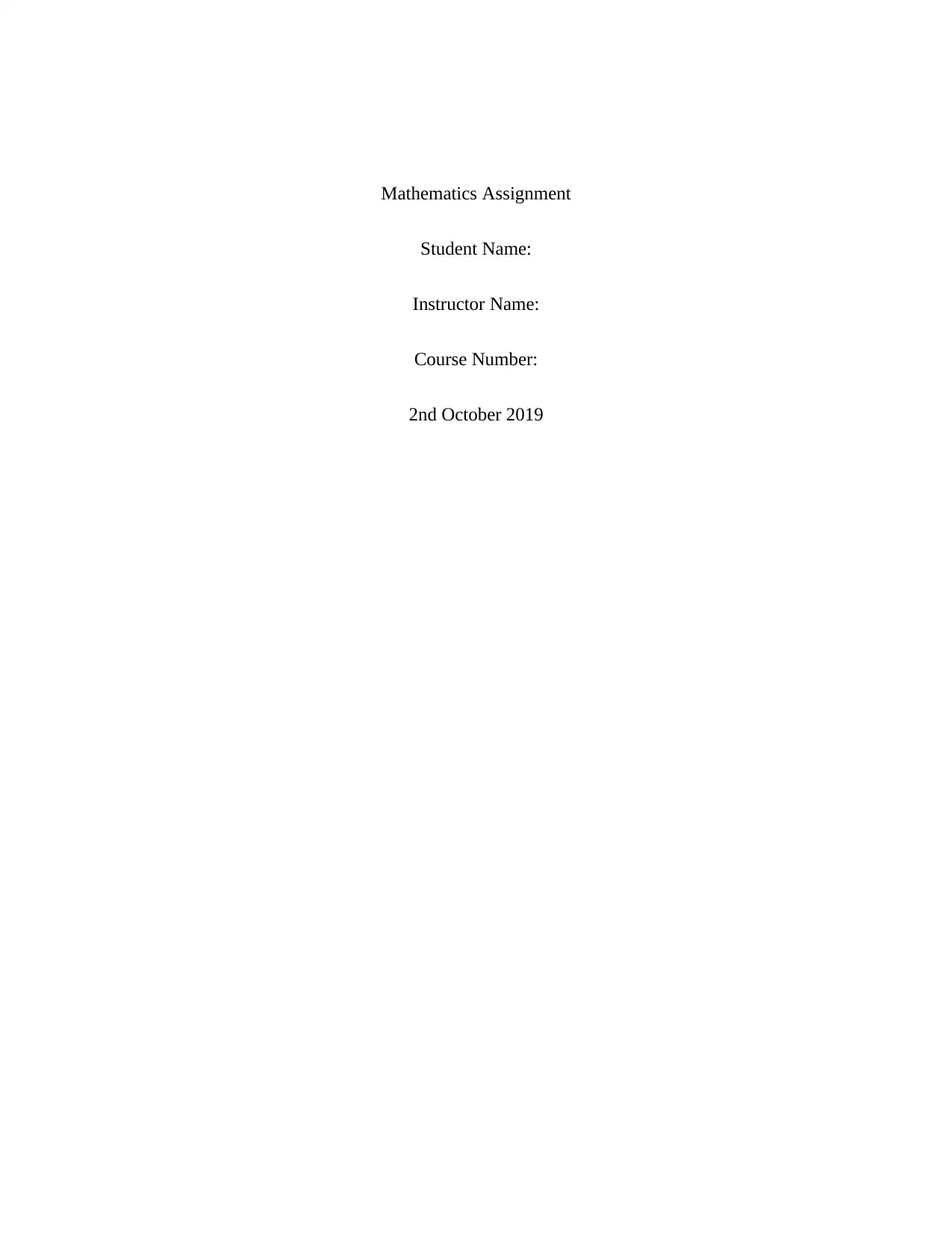
Mathematics Assignment
Student Name:
Instructor Name:
Course Number:
2nd October 2019
Student Name:
Instructor Name:
Course Number:
2nd October 2019
Paraphrase This Document
Need a fresh take? Get an instant paraphrase of this document with our AI Paraphraser
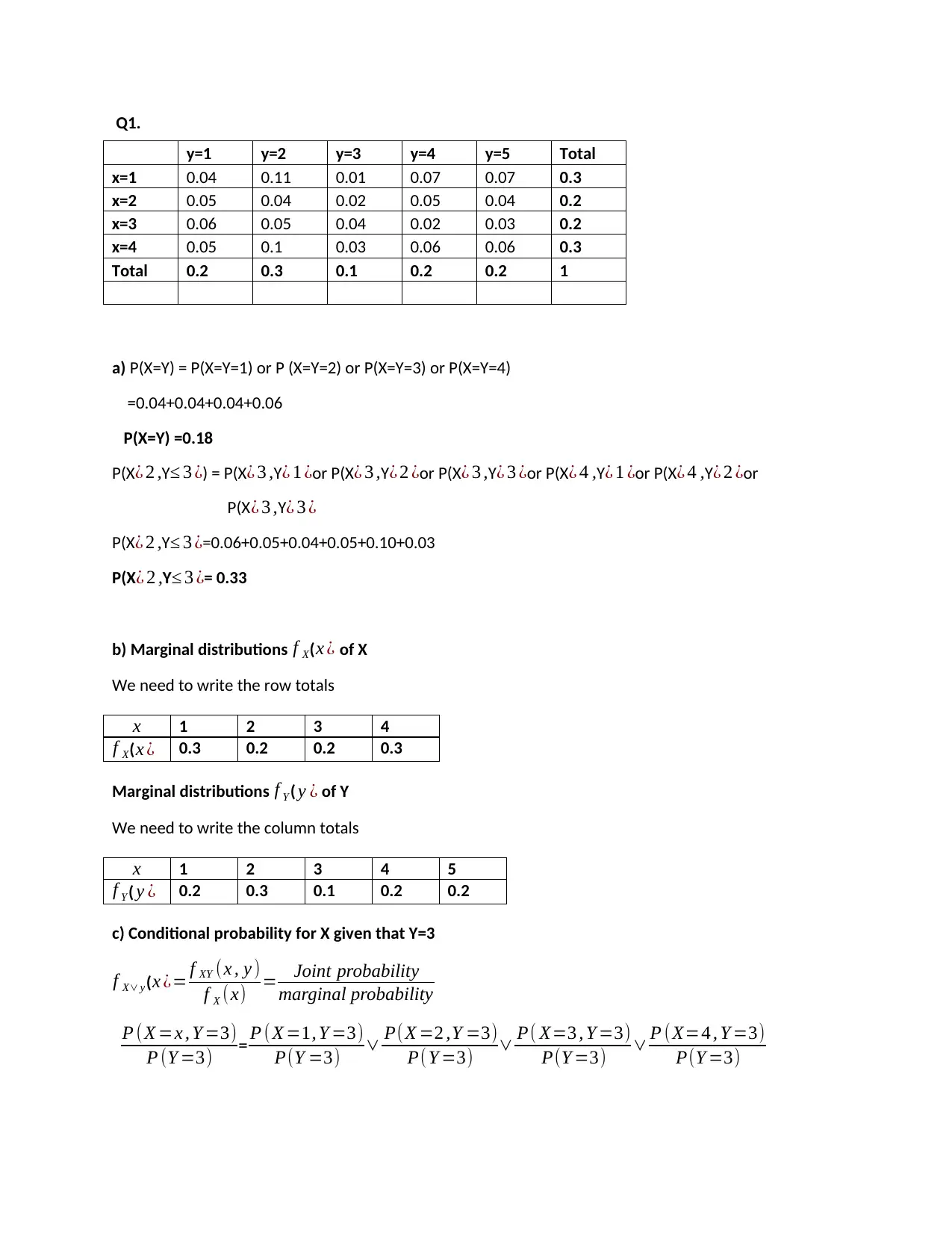
Q1.
a) P(X=Y) = P(X=Y=1) or P (X=Y=2) or P(X=Y=3) or P(X=Y=4)
=0.04+0.04+0.04+0.06
P(X=Y) =0.18
P(X¿ 2 ,Y≤ 3 ¿) = P(X¿ 3 ,Y¿ 1 ¿or P(X¿ 3 ,Y¿ 2 ¿or P(X¿ 3 ,Y¿ 3 ¿or P(X¿ 4 ,Y¿ 1 ¿or P(X¿ 4 ,Y¿ 2 ¿or
P(X¿ 3 ,Y¿ 3 ¿
P(X¿ 2 ,Y≤ 3 ¿=0.06+0.05+0.04+0.05+0.10+0.03
P(X¿ 2 ,Y≤ 3 ¿= 0.33
b) Marginal distributions f X(x ¿ of X
We need to write the row totals
Marginal distributions f Y ( y ¿ of Y
We need to write the column totals
c) Conditional probability for X given that Y=3
f X∨ y ( x ¿= f XY (x , y )
f X (x) = Joint probability
marginal probability
P (X =x , Y =3)
P (Y =3) = P ( X =1, Y =3)
P(Y =3) ∨ P(X =2 ,Y =3)
P(Y =3) ∨ P( X=3 , Y =3)
P(Y =3) ∨ P (X=4 , Y =3)
P(Y =3)
y=1 y=2 y=3 y=4 y=5 Total
x=1 0.04 0.11 0.01 0.07 0.07 0.3
x=2 0.05 0.04 0.02 0.05 0.04 0.2
x=3 0.06 0.05 0.04 0.02 0.03 0.2
x=4 0.05 0.1 0.03 0.06 0.06 0.3
Total 0.2 0.3 0.1 0.2 0.2 1
x 1 2 3 4
f X( x ¿ 0.3 0.2 0.2 0.3
x 1 2 3 4 5
f Y ( y ¿ 0.2 0.3 0.1 0.2 0.2
a) P(X=Y) = P(X=Y=1) or P (X=Y=2) or P(X=Y=3) or P(X=Y=4)
=0.04+0.04+0.04+0.06
P(X=Y) =0.18
P(X¿ 2 ,Y≤ 3 ¿) = P(X¿ 3 ,Y¿ 1 ¿or P(X¿ 3 ,Y¿ 2 ¿or P(X¿ 3 ,Y¿ 3 ¿or P(X¿ 4 ,Y¿ 1 ¿or P(X¿ 4 ,Y¿ 2 ¿or
P(X¿ 3 ,Y¿ 3 ¿
P(X¿ 2 ,Y≤ 3 ¿=0.06+0.05+0.04+0.05+0.10+0.03
P(X¿ 2 ,Y≤ 3 ¿= 0.33
b) Marginal distributions f X(x ¿ of X
We need to write the row totals
Marginal distributions f Y ( y ¿ of Y
We need to write the column totals
c) Conditional probability for X given that Y=3
f X∨ y ( x ¿= f XY (x , y )
f X (x) = Joint probability
marginal probability
P (X =x , Y =3)
P (Y =3) = P ( X =1, Y =3)
P(Y =3) ∨ P(X =2 ,Y =3)
P(Y =3) ∨ P( X=3 , Y =3)
P(Y =3) ∨ P (X=4 , Y =3)
P(Y =3)
y=1 y=2 y=3 y=4 y=5 Total
x=1 0.04 0.11 0.01 0.07 0.07 0.3
x=2 0.05 0.04 0.02 0.05 0.04 0.2
x=3 0.06 0.05 0.04 0.02 0.03 0.2
x=4 0.05 0.1 0.03 0.06 0.06 0.3
Total 0.2 0.3 0.1 0.2 0.2 1
x 1 2 3 4
f X( x ¿ 0.3 0.2 0.2 0.3
x 1 2 3 4 5
f Y ( y ¿ 0.2 0.3 0.1 0.2 0.2
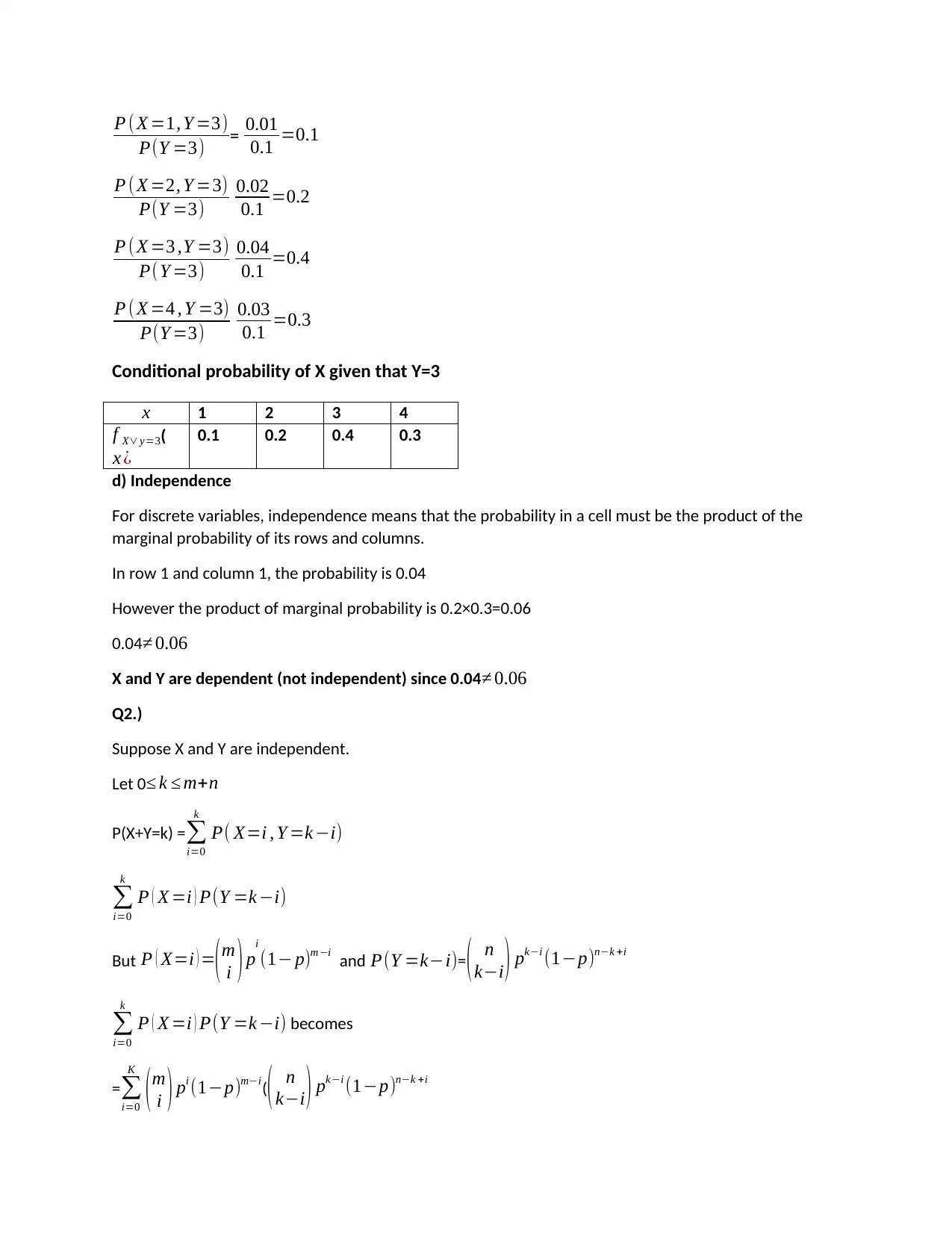
P (X =1, Y =3)
P(Y =3) = 0.01
0.1 =0.1
P ( X =2, Y =3)
P(Y =3)
0.02
0.1 =0.2
P (X =3 ,Y =3)
P(Y =3)
0.04
0.1 =0.4
P ( X =4 , Y =3)
P(Y =3)
0.03
0.1 =0.3
Conditional probability of X given that Y=3
d) Independence
For discrete variables, independence means that the probability in a cell must be the product of the
marginal probability of its rows and columns.
In row 1 and column 1, the probability is 0.04
However the product of marginal probability is 0.2×0.3=0.06
0.04≠ 0.06
X and Y are dependent (not independent) since 0.04 ≠ 0.06
Q2.)
Suppose X and Y are independent.
Let 0≤ k ≤ m+n
P(X+Y=k) =∑
i=0
k
P( X=i , Y =k −i)
∑
i=0
k
P ( X =i ) P(Y =k −i)
But P ( X=i ) =(m
i ) pi
(1− p)m −i and P(Y =k−i)=( n
k−i ) pk−i (1−p)n−k +i
∑
i=0
k
P ( X =i ) P(Y =k −i) becomes
=∑
i=0
K
(m
i ) pi (1−p)m−i(( n
k−i ) pk−i (1−p)n−k +i
x 1 2 3 4
f X∨ y=3(
x ¿
0.1 0.2 0.4 0.3
P(Y =3) = 0.01
0.1 =0.1
P ( X =2, Y =3)
P(Y =3)
0.02
0.1 =0.2
P (X =3 ,Y =3)
P(Y =3)
0.04
0.1 =0.4
P ( X =4 , Y =3)
P(Y =3)
0.03
0.1 =0.3
Conditional probability of X given that Y=3
d) Independence
For discrete variables, independence means that the probability in a cell must be the product of the
marginal probability of its rows and columns.
In row 1 and column 1, the probability is 0.04
However the product of marginal probability is 0.2×0.3=0.06
0.04≠ 0.06
X and Y are dependent (not independent) since 0.04 ≠ 0.06
Q2.)
Suppose X and Y are independent.
Let 0≤ k ≤ m+n
P(X+Y=k) =∑
i=0
k
P( X=i , Y =k −i)
∑
i=0
k
P ( X =i ) P(Y =k −i)
But P ( X=i ) =(m
i ) pi
(1− p)m −i and P(Y =k−i)=( n
k−i ) pk−i (1−p)n−k +i
∑
i=0
k
P ( X =i ) P(Y =k −i) becomes
=∑
i=0
K
(m
i ) pi (1−p)m−i(( n
k−i ) pk−i (1−p)n−k +i
x 1 2 3 4
f X∨ y=3(
x ¿
0.1 0.2 0.4 0.3
⊘ This is a preview!⊘
Do you want full access?
Subscribe today to unlock all pages.

Trusted by 1+ million students worldwide
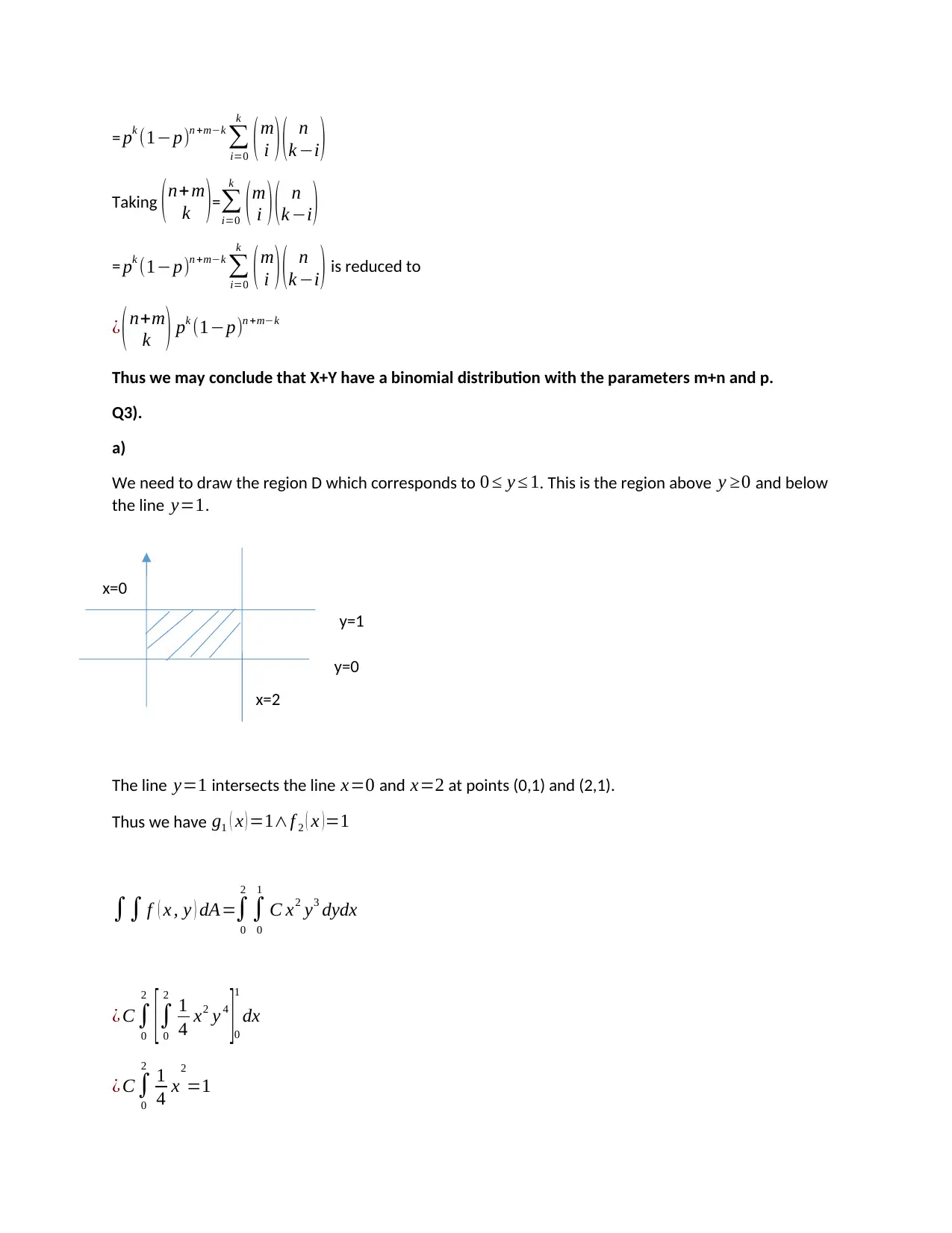
= pk (1−p)n +m−k
∑
i=0
k
(m
i )( n
k −i )
Taking (n+ m
k )=∑
i=0
k
(m
i )( n
k −i )
= pk (1−p)n +m−k
∑
i=0
k
(m
i )( n
k −i ) is reduced to
¿ (n+m
k ) pk (1−p)n +m−k
Thus we may conclude that X+Y have a binomial distribution with the parameters m+n and p.
Q3).
a)
We need to draw the region D which corresponds to 0 ≤ y ≤ 1. This is the region above y ≥0 and below
the line y=1.
The line y=1 intersects the line x=0 and x=2 at points (0,1) and (2,1).
Thus we have g1 ( x ) =1∧f 2 ( x ) =1
∫∫ f ( x , y ) dA=∫
0
2
∫
0
1
C x2 y3 dydx
¿ C∫
0
2
[∫
0
2
1
4 x2 y 4
]0
1
dx
¿ C∫
0
2
1
4 x
2
=1
y=1
y=0
x=2
x=0
∑
i=0
k
(m
i )( n
k −i )
Taking (n+ m
k )=∑
i=0
k
(m
i )( n
k −i )
= pk (1−p)n +m−k
∑
i=0
k
(m
i )( n
k −i ) is reduced to
¿ (n+m
k ) pk (1−p)n +m−k
Thus we may conclude that X+Y have a binomial distribution with the parameters m+n and p.
Q3).
a)
We need to draw the region D which corresponds to 0 ≤ y ≤ 1. This is the region above y ≥0 and below
the line y=1.
The line y=1 intersects the line x=0 and x=2 at points (0,1) and (2,1).
Thus we have g1 ( x ) =1∧f 2 ( x ) =1
∫∫ f ( x , y ) dA=∫
0
2
∫
0
1
C x2 y3 dydx
¿ C∫
0
2
[∫
0
2
1
4 x2 y 4
]0
1
dx
¿ C∫
0
2
1
4 x
2
=1
y=1
y=0
x=2
x=0
Paraphrase This Document
Need a fresh take? Get an instant paraphrase of this document with our AI Paraphraser
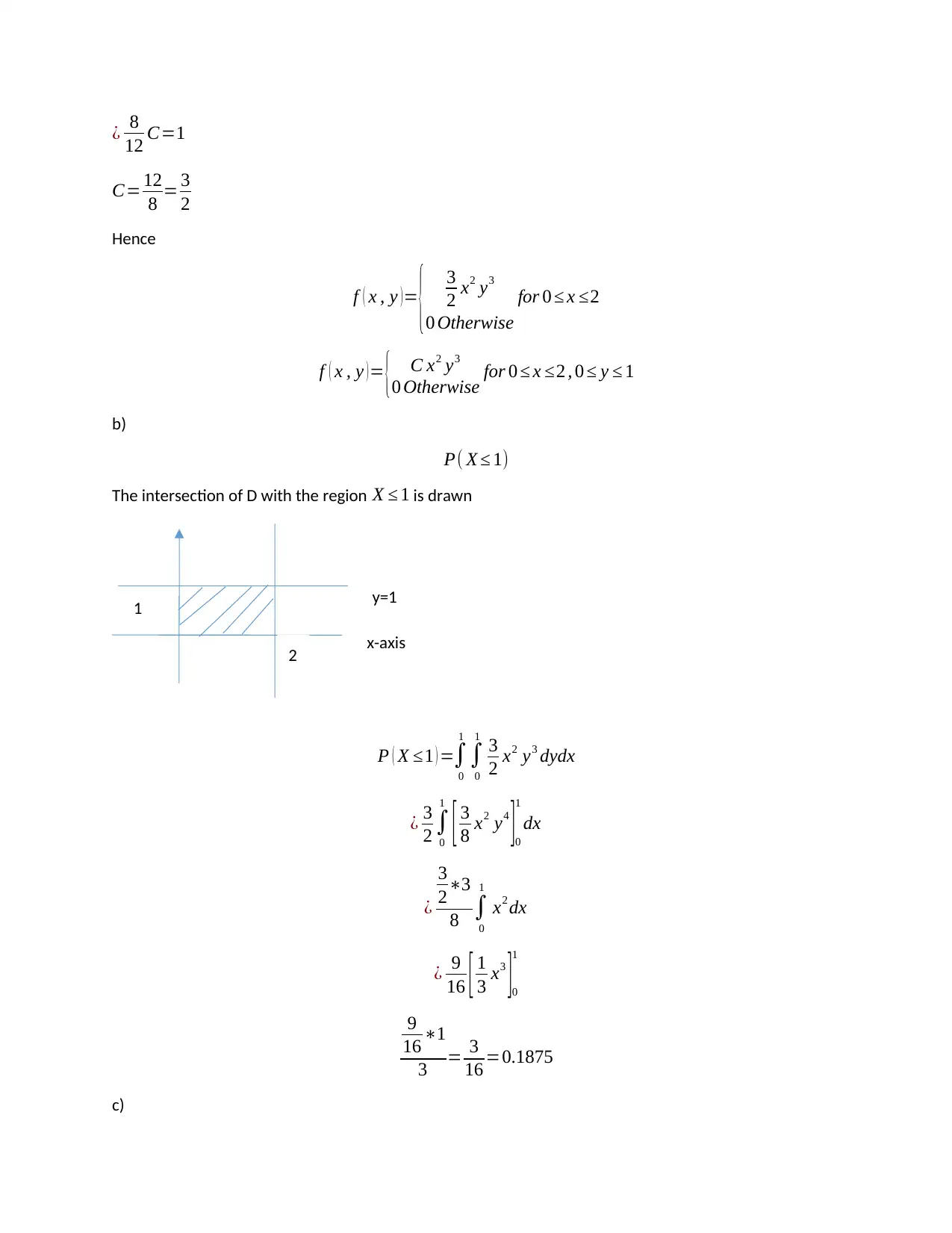
¿ 8
12 C=1
C= 12
8 = 3
2
Hence
f ( x , y )= { 3
2 x2 y3
0 Otherwise
for 0 ≤ x ≤2
f ( x , y ) = { C x2 y3
0 Otherwise for 0 ≤ x ≤2 , 0 ≤ y ≤ 1
b)
P( X ≤ 1)
The intersection of D with the region X ≤ 1 is drawn
P ( X ≤1 ) =∫
0
1
∫
0
1
3
2 x2 y3 dydx
¿ 3
2 ∫
0
1
[ 3
8 x2 y4
]0
1
dx
¿
3
2∗3
8 ∫
0
1
x2 dx
¿ 9
16 [ 1
3 x3
]0
1
9
16 ∗1
3 = 3
16 =0.1875
c)
y=1
x-axis
2
1
12 C=1
C= 12
8 = 3
2
Hence
f ( x , y )= { 3
2 x2 y3
0 Otherwise
for 0 ≤ x ≤2
f ( x , y ) = { C x2 y3
0 Otherwise for 0 ≤ x ≤2 , 0 ≤ y ≤ 1
b)
P( X ≤ 1)
The intersection of D with the region X ≤ 1 is drawn
P ( X ≤1 ) =∫
0
1
∫
0
1
3
2 x2 y3 dydx
¿ 3
2 ∫
0
1
[ 3
8 x2 y4
]0
1
dx
¿
3
2∗3
8 ∫
0
1
x2 dx
¿ 9
16 [ 1
3 x3
]0
1
9
16 ∗1
3 = 3
16 =0.1875
c)
y=1
x-axis
2
1
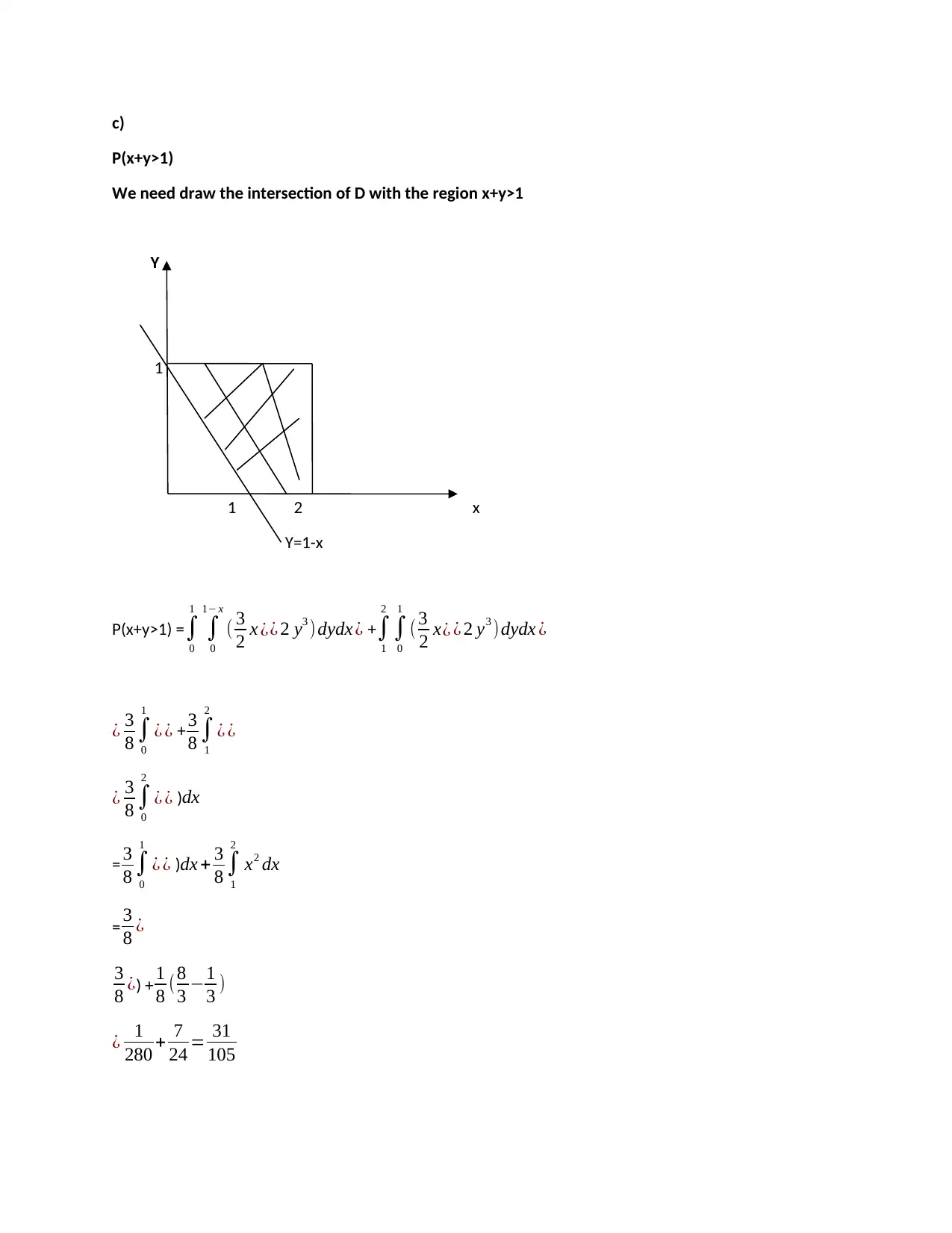
c)
P(x+y>1)
We need draw the intersection of D with the region x+y>1
Y
1
1 2 x
Y=1-x
P(x+y>1) =∫
0
1
∫
0
1− x
( 3
2 x ¿¿ 2 y3 )dydx ¿ +∫
1
2
∫
0
1
( 3
2 x¿ ¿ 2 y3 )dydx ¿
¿ 3
8 ∫
0
1
¿ ¿ + 3
8 ∫
1
2
¿ ¿
¿ 3
8 ∫
0
2
¿ ¿ )dx
= 3
8 ∫
0
1
¿ ¿ )dx + 3
8 ∫
1
2
x2 dx
= 3
8 ¿
3
8 ¿) + 1
8 (8
3 −1
3 )
¿ 1
280 + 7
24 = 31
105
P(x+y>1)
We need draw the intersection of D with the region x+y>1
Y
1
1 2 x
Y=1-x
P(x+y>1) =∫
0
1
∫
0
1− x
( 3
2 x ¿¿ 2 y3 )dydx ¿ +∫
1
2
∫
0
1
( 3
2 x¿ ¿ 2 y3 )dydx ¿
¿ 3
8 ∫
0
1
¿ ¿ + 3
8 ∫
1
2
¿ ¿
¿ 3
8 ∫
0
2
¿ ¿ )dx
= 3
8 ∫
0
1
¿ ¿ )dx + 3
8 ∫
1
2
x2 dx
= 3
8 ¿
3
8 ¿) + 1
8 (8
3 −1
3 )
¿ 1
280 + 7
24 = 31
105
⊘ This is a preview!⊘
Do you want full access?
Subscribe today to unlock all pages.

Trusted by 1+ million students worldwide
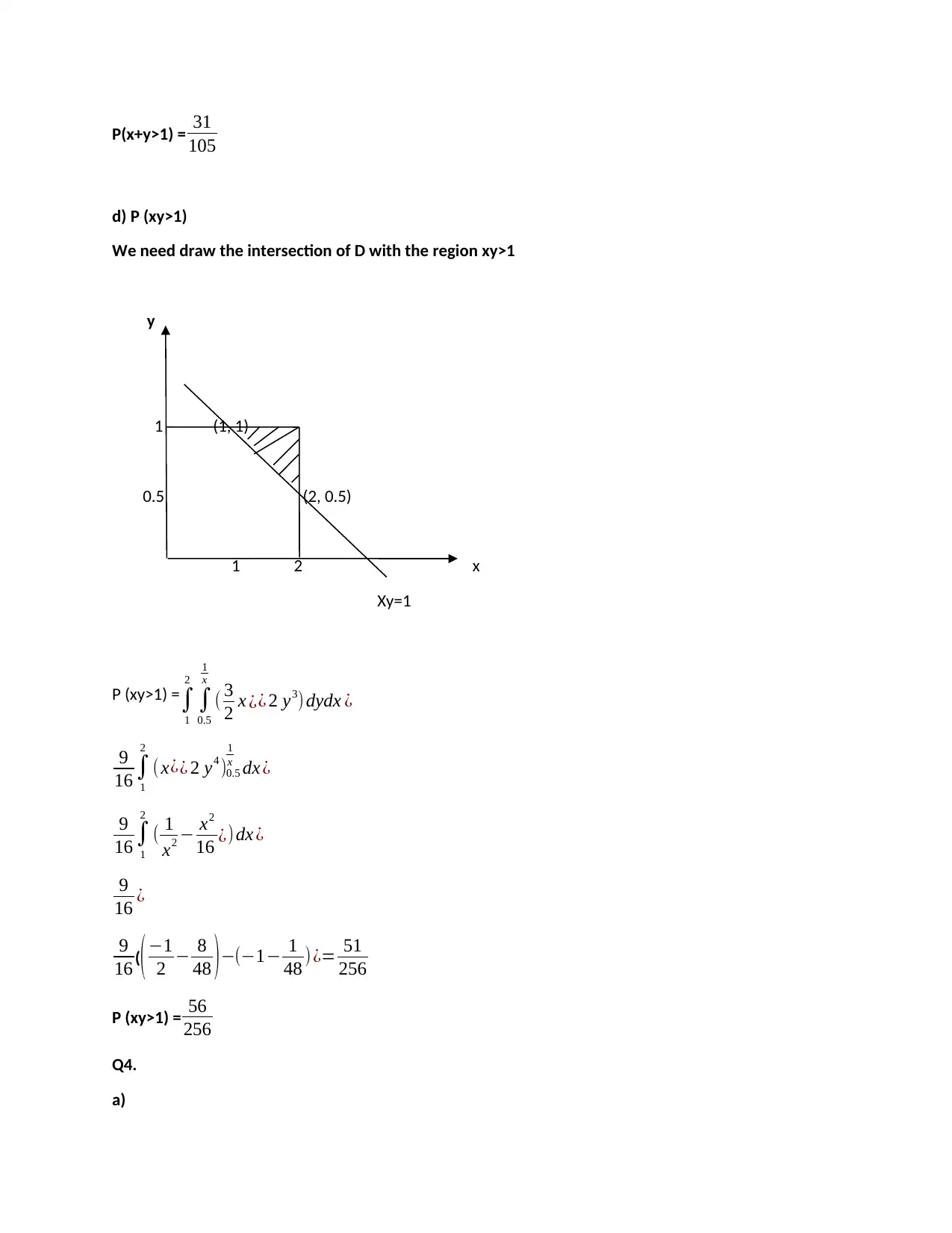
P(x+y>1) = 31
105
d) P (xy>1)
We need draw the intersection of D with the region xy>1
y
1 (1, 1)
0.5 (2, 0.5)
1 2 x
Xy=1
P (xy>1) =
∫
1
2
∫
0.5
1
x
( 3
2 x ¿¿ 2 y3) dydx ¿
9
16 ∫
1
2
( x¿¿ 2 y4 )0.5
1
x dx ¿
9
16 ∫
1
2
( 1
x2 − x2
16 ¿) dx ¿
9
16 ¿
9
16 (( −1
2 − 8
48 ) −(−1− 1
48 ) ¿= 51
256
P (xy>1) = 56
256
Q4.
a)
105
d) P (xy>1)
We need draw the intersection of D with the region xy>1
y
1 (1, 1)
0.5 (2, 0.5)
1 2 x
Xy=1
P (xy>1) =
∫
1
2
∫
0.5
1
x
( 3
2 x ¿¿ 2 y3) dydx ¿
9
16 ∫
1
2
( x¿¿ 2 y4 )0.5
1
x dx ¿
9
16 ∫
1
2
( 1
x2 − x2
16 ¿) dx ¿
9
16 ¿
9
16 (( −1
2 − 8
48 ) −(−1− 1
48 ) ¿= 51
256
P (xy>1) = 56
256
Q4.
a)
Paraphrase This Document
Need a fresh take? Get an instant paraphrase of this document with our AI Paraphraser
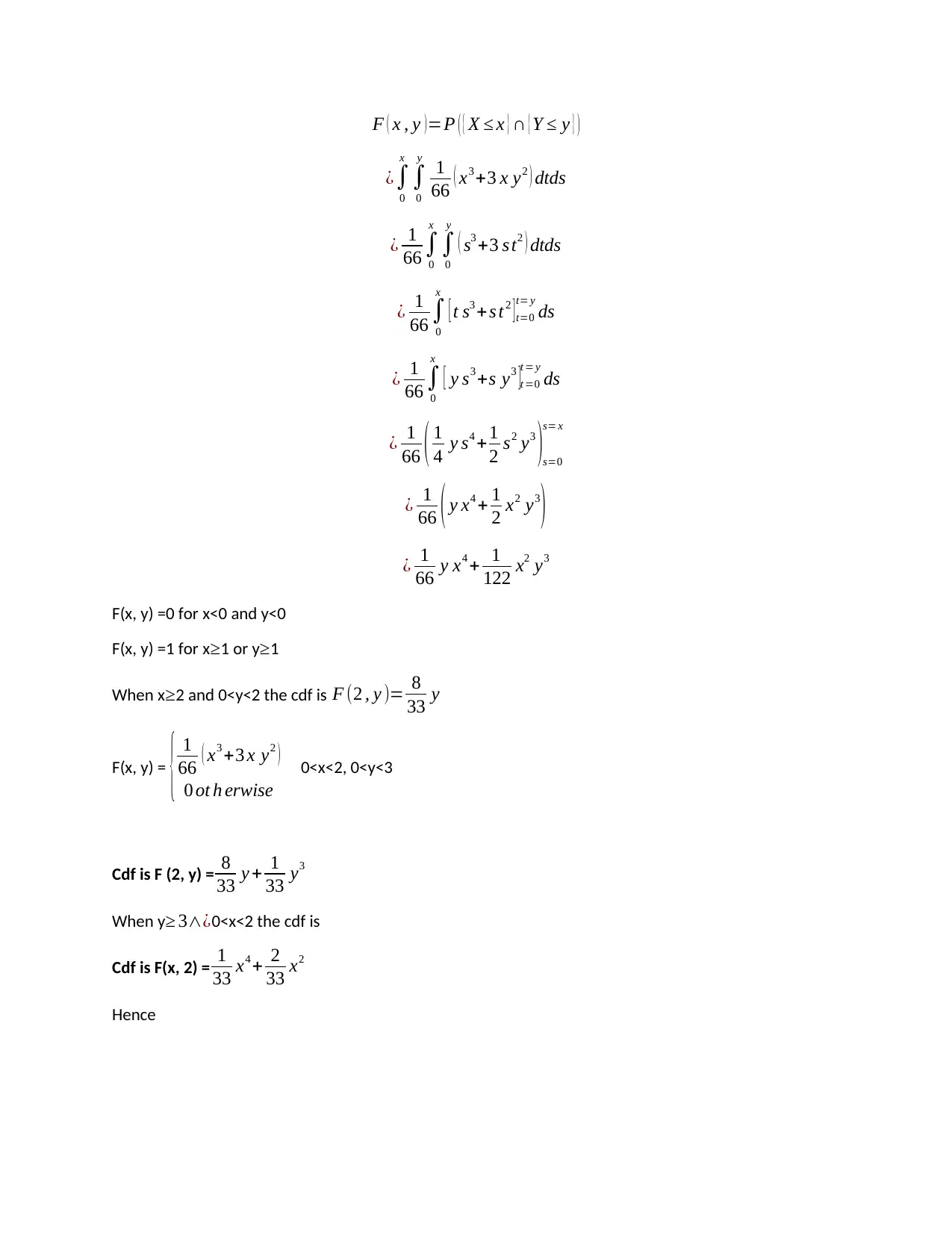
F ( x , y )=P ( { X ≤ x } ∩ { Y ≤ y } )
¿∫
0
x
∫
0
y
1
66 ( x3 +3 x y2 ) dtds
¿ 1
66 ∫
0
x
∫
0
y
( s3 +3 s t2 ) dtds
¿ 1
66 ∫
0
x
[ t s3 +s t2 ]t=0
t= y
ds
¿ 1
66 ∫
0
x
[ y s3 +s y3 ]t =0
t = y
ds
¿ 1
66 ( 1
4 y s4 + 1
2 s2 y3
)s=0
s= x
¿ 1
66 ( y x4 + 1
2 x2 y3
)
¿ 1
66 y x4 + 1
122 x2 y3
F(x, y) =0 for x<0 and y<0
F(x, y) =1 for x≥1 or y≥1
When x≥2 and 0<y<2 the cdf is F (2 , y )= 8
33 y
F(x, y) = { 1
66 ( x3 +3 x y2 )
0 ot h erwise
0<x<2, 0<y<3
Cdf is F (2, y) = 8
33 y + 1
33 y3
When y≥ 3∧¿0<x<2 the cdf is
Cdf is F(x, 2) = 1
33 x4 + 2
33 x2
Hence
¿∫
0
x
∫
0
y
1
66 ( x3 +3 x y2 ) dtds
¿ 1
66 ∫
0
x
∫
0
y
( s3 +3 s t2 ) dtds
¿ 1
66 ∫
0
x
[ t s3 +s t2 ]t=0
t= y
ds
¿ 1
66 ∫
0
x
[ y s3 +s y3 ]t =0
t = y
ds
¿ 1
66 ( 1
4 y s4 + 1
2 s2 y3
)s=0
s= x
¿ 1
66 ( y x4 + 1
2 x2 y3
)
¿ 1
66 y x4 + 1
122 x2 y3
F(x, y) =0 for x<0 and y<0
F(x, y) =1 for x≥1 or y≥1
When x≥2 and 0<y<2 the cdf is F (2 , y )= 8
33 y
F(x, y) = { 1
66 ( x3 +3 x y2 )
0 ot h erwise
0<x<2, 0<y<3
Cdf is F (2, y) = 8
33 y + 1
33 y3
When y≥ 3∧¿0<x<2 the cdf is
Cdf is F(x, 2) = 1
33 x4 + 2
33 x2
Hence
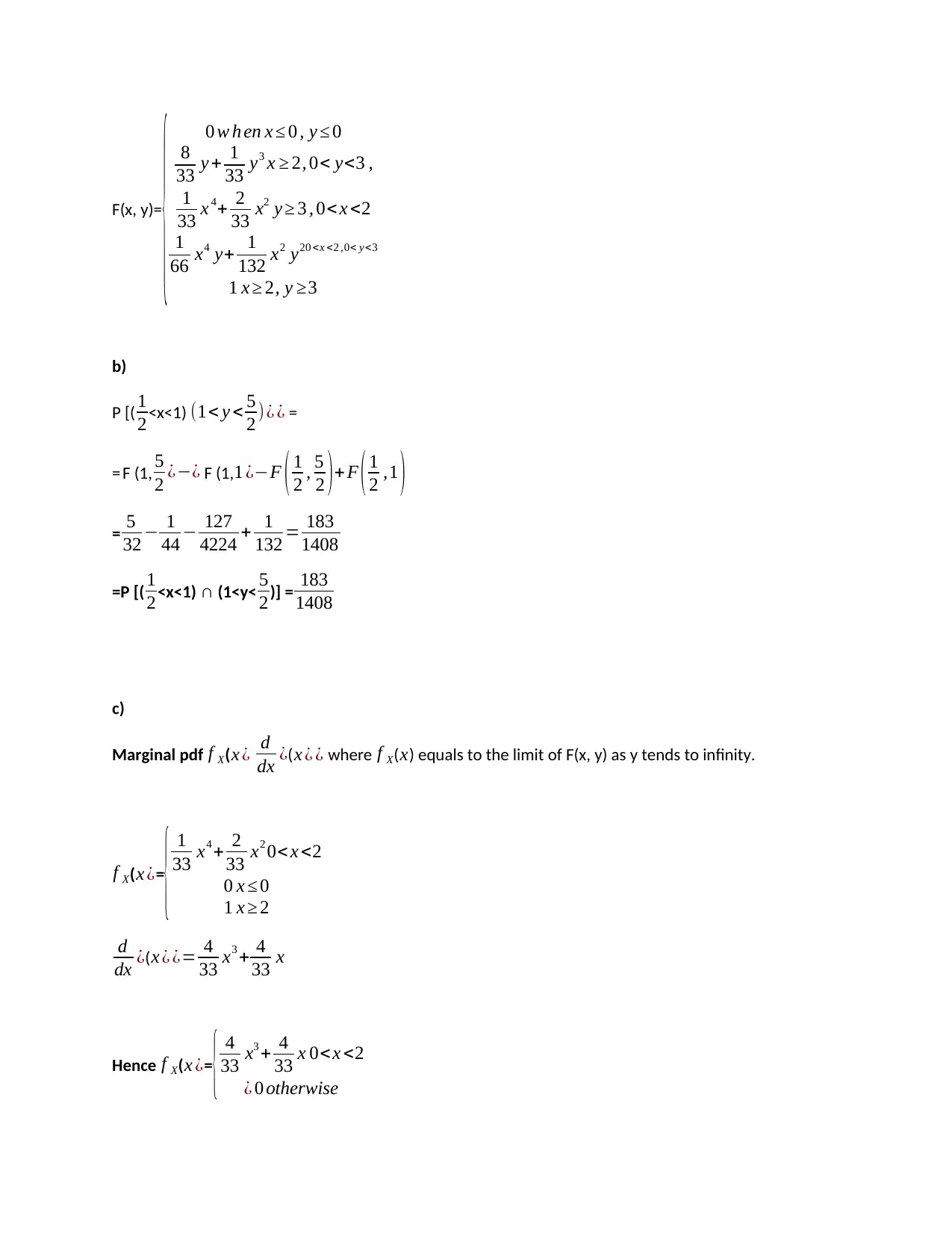
F(x, y)=
{ 0 w h en x ≤ 0 , y ≤ 0
8
33 y + 1
33 y3 x ≥ 2, 0< y<3 ,
1
33 x 4+ 2
33 x2 y ≥ 3 , 0< x <2
1
66 x4 y+ 1
132 x2 y20 <x <2 ,0< y<3
1 x ≥ 2, y ≥3
b)
P [( 1
2<x<1) (1< y < 5
2 ) ¿ ¿ =
= F (1, 5
2 ¿−¿ F (1, 1 ¿−F ( 1
2 , 5
2 ) + F ( 1
2 ,1 )
= 5
32 − 1
44 − 127
4224 + 1
132 = 183
1408
=P [( 1
2<x<1) ∩ (1<y< 5
2)] = 183
1408
c)
Marginal pdf f X( x ¿ d
dx ¿( x ¿ ¿ where f X( x) equals to the limit of F(x, y) as y tends to infinity.
f X(x ¿=
{ 1
33 x4 + 2
33 x2 0< x <2
0 x ≤ 0
1 x ≥ 2
d
dx ¿(x ¿ ¿= 4
33 x3 + 4
33 x
Hence f X( x ¿=
{ 4
33 x3 + 4
33 x 0<x <2
¿ 0 otherwise
{ 0 w h en x ≤ 0 , y ≤ 0
8
33 y + 1
33 y3 x ≥ 2, 0< y<3 ,
1
33 x 4+ 2
33 x2 y ≥ 3 , 0< x <2
1
66 x4 y+ 1
132 x2 y20 <x <2 ,0< y<3
1 x ≥ 2, y ≥3
b)
P [( 1
2<x<1) (1< y < 5
2 ) ¿ ¿ =
= F (1, 5
2 ¿−¿ F (1, 1 ¿−F ( 1
2 , 5
2 ) + F ( 1
2 ,1 )
= 5
32 − 1
44 − 127
4224 + 1
132 = 183
1408
=P [( 1
2<x<1) ∩ (1<y< 5
2)] = 183
1408
c)
Marginal pdf f X( x ¿ d
dx ¿( x ¿ ¿ where f X( x) equals to the limit of F(x, y) as y tends to infinity.
f X(x ¿=
{ 1
33 x4 + 2
33 x2 0< x <2
0 x ≤ 0
1 x ≥ 2
d
dx ¿(x ¿ ¿= 4
33 x3 + 4
33 x
Hence f X( x ¿=
{ 4
33 x3 + 4
33 x 0<x <2
¿ 0 otherwise
⊘ This is a preview!⊘
Do you want full access?
Subscribe today to unlock all pages.

Trusted by 1+ million students worldwide
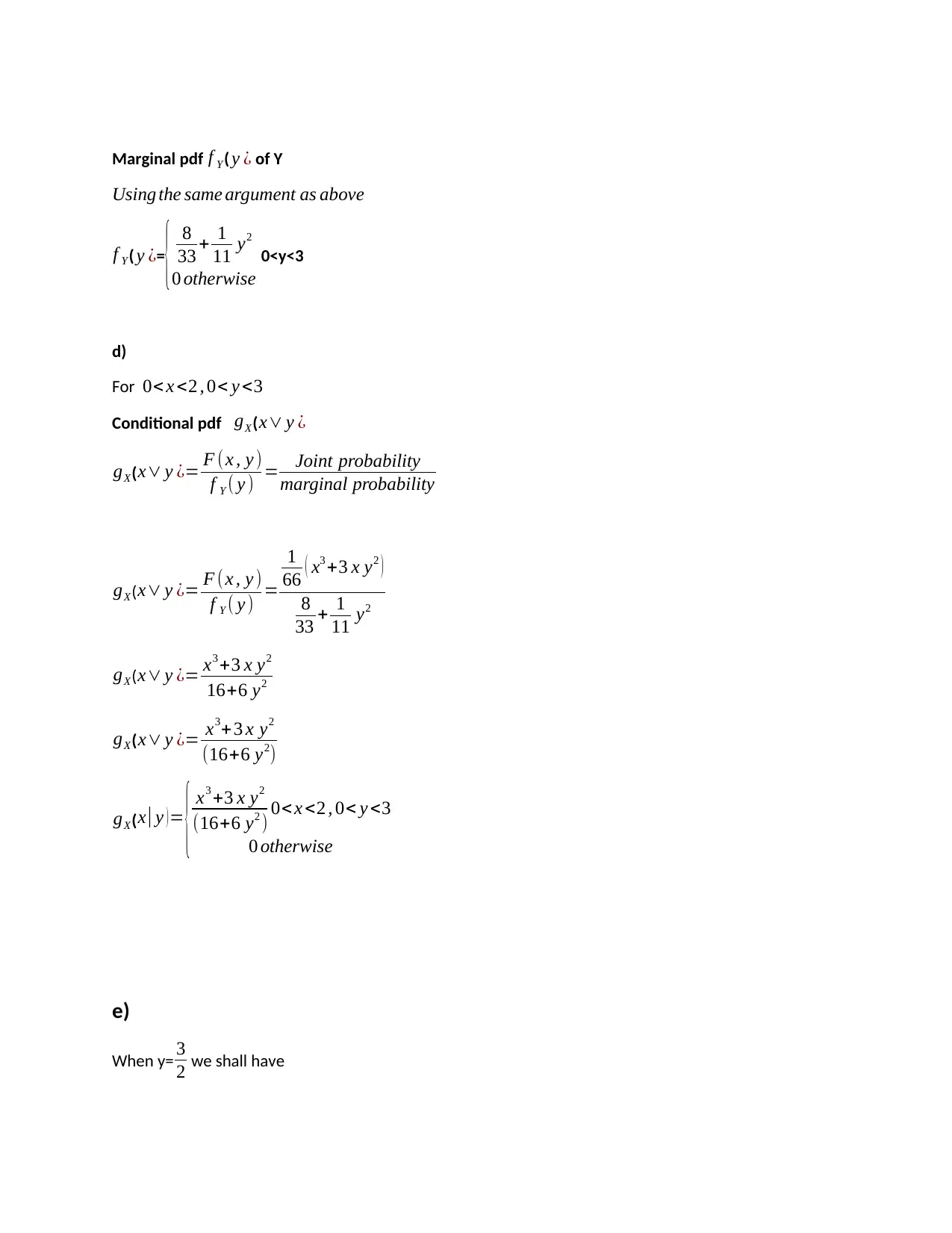
Marginal pdf f Y ( y ¿ of Y
Using the same argument as above
f Y ( y ¿=
{ 8
33 + 1
11 y2
0 otherwise
0<y<3
d)
For 0< x <2 , 0< y <3
Conditional pdf gX( x∨ y ¿
gX(x∨ y ¿= F (x , y )
f Y ( y ) = Joint probability
marginal probability
gX( x∨ y ¿= F (x , y )
f Y ( y ) =
1
66 ( x3 +3 x y2 )
8
33 + 1
11 y2
gX( x∨ y ¿= x3 +3 x y2
16+6 y2
gX( x∨ y ¿= x3+3 x y2
(16+6 y2)
gX(x| y )=
{ x3 +3 x y2
(16+6 y2 ) 0< x <2 , 0< y <3
0 otherwise
e)
When y= 3
2 we shall have
Using the same argument as above
f Y ( y ¿=
{ 8
33 + 1
11 y2
0 otherwise
0<y<3
d)
For 0< x <2 , 0< y <3
Conditional pdf gX( x∨ y ¿
gX(x∨ y ¿= F (x , y )
f Y ( y ) = Joint probability
marginal probability
gX( x∨ y ¿= F (x , y )
f Y ( y ) =
1
66 ( x3 +3 x y2 )
8
33 + 1
11 y2
gX( x∨ y ¿= x3 +3 x y2
16+6 y2
gX( x∨ y ¿= x3+3 x y2
(16+6 y2)
gX(x| y )=
{ x3 +3 x y2
(16+6 y2 ) 0< x <2 , 0< y <3
0 otherwise
e)
When y= 3
2 we shall have
Paraphrase This Document
Need a fresh take? Get an instant paraphrase of this document with our AI Paraphraser
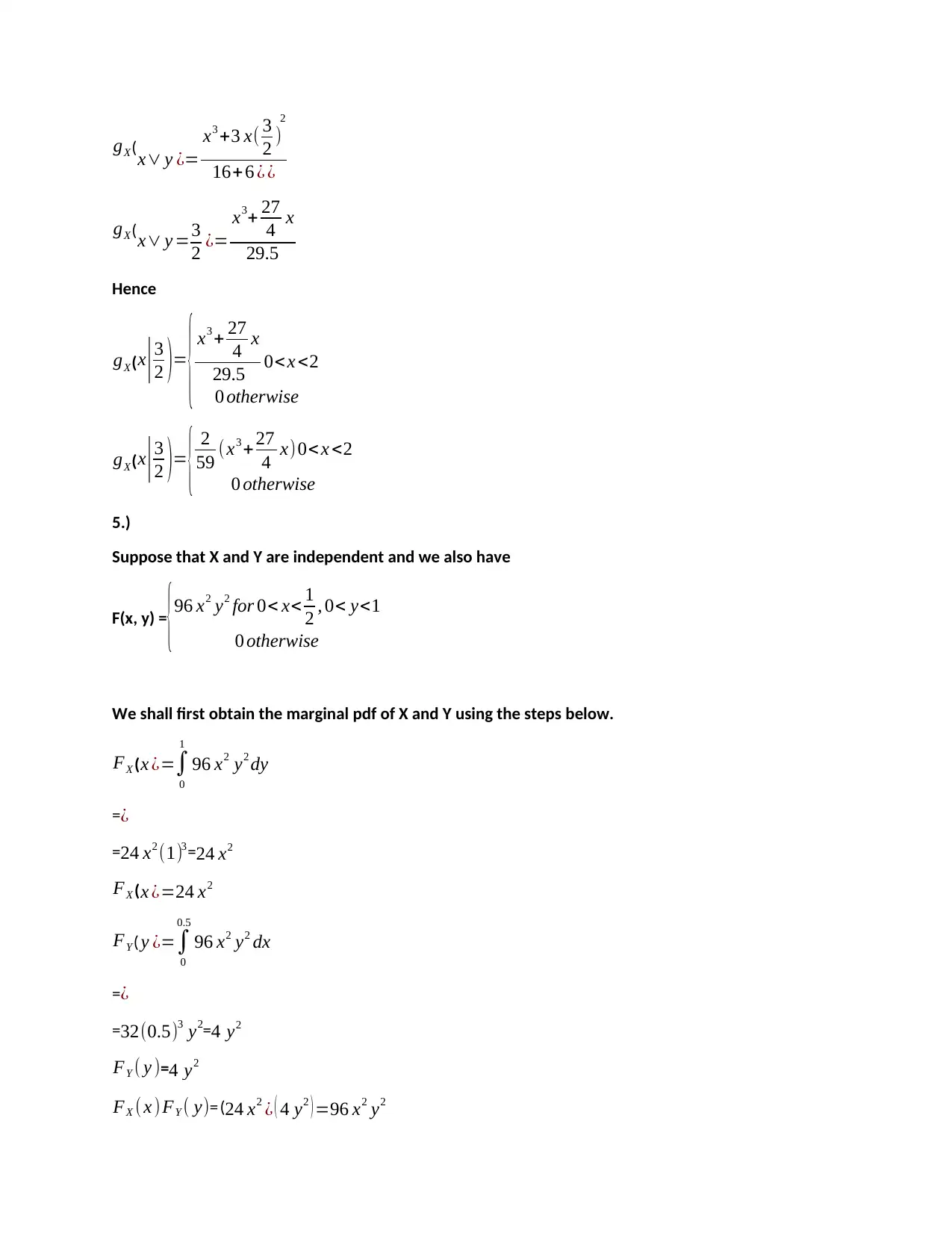
gX(x∨ y ¿=
x3 +3 x( 3
2 )
2
16+6 ¿ ¿
gX(x∨ y =3
2 ¿=
x3+ 27
4 x
29.5
Hence
gX( x| 3
2 )=
{ x3 + 27
4 x
29.5 0<x <2
0 otherwise
gX(x|3
2 )= { 2
59 (x3 + 27
4 x)0< x <2
0 otherwise
5.)
Suppose that X and Y are independent and we also have
F(x, y) = {96 x2 y2 for 0< x< 1
2 , 0< y<1
0 otherwise
We shall first obtain the marginal pdf of X and Y using the steps below.
FX ( x ¿=∫
0
1
96 x2 y2 dy
=¿
=24 x2 (1)3=24 x2
FX (x ¿=24 x2
FY ( y ¿=∫
0
0.5
96 x2 y2 dx
=¿
=32(0.5)3 y2=4 y2
FY ( y )=4 y2
FX ( x )FY ( y)=(24 x2 ¿ ( 4 y2 ) =96 x2 y2
x3 +3 x( 3
2 )
2
16+6 ¿ ¿
gX(x∨ y =3
2 ¿=
x3+ 27
4 x
29.5
Hence
gX( x| 3
2 )=
{ x3 + 27
4 x
29.5 0<x <2
0 otherwise
gX(x|3
2 )= { 2
59 (x3 + 27
4 x)0< x <2
0 otherwise
5.)
Suppose that X and Y are independent and we also have
F(x, y) = {96 x2 y2 for 0< x< 1
2 , 0< y<1
0 otherwise
We shall first obtain the marginal pdf of X and Y using the steps below.
FX ( x ¿=∫
0
1
96 x2 y2 dy
=¿
=24 x2 (1)3=24 x2
FX (x ¿=24 x2
FY ( y ¿=∫
0
0.5
96 x2 y2 dx
=¿
=32(0.5)3 y2=4 y2
FY ( y )=4 y2
FX ( x )FY ( y)=(24 x2 ¿ ( 4 y2 ) =96 x2 y2
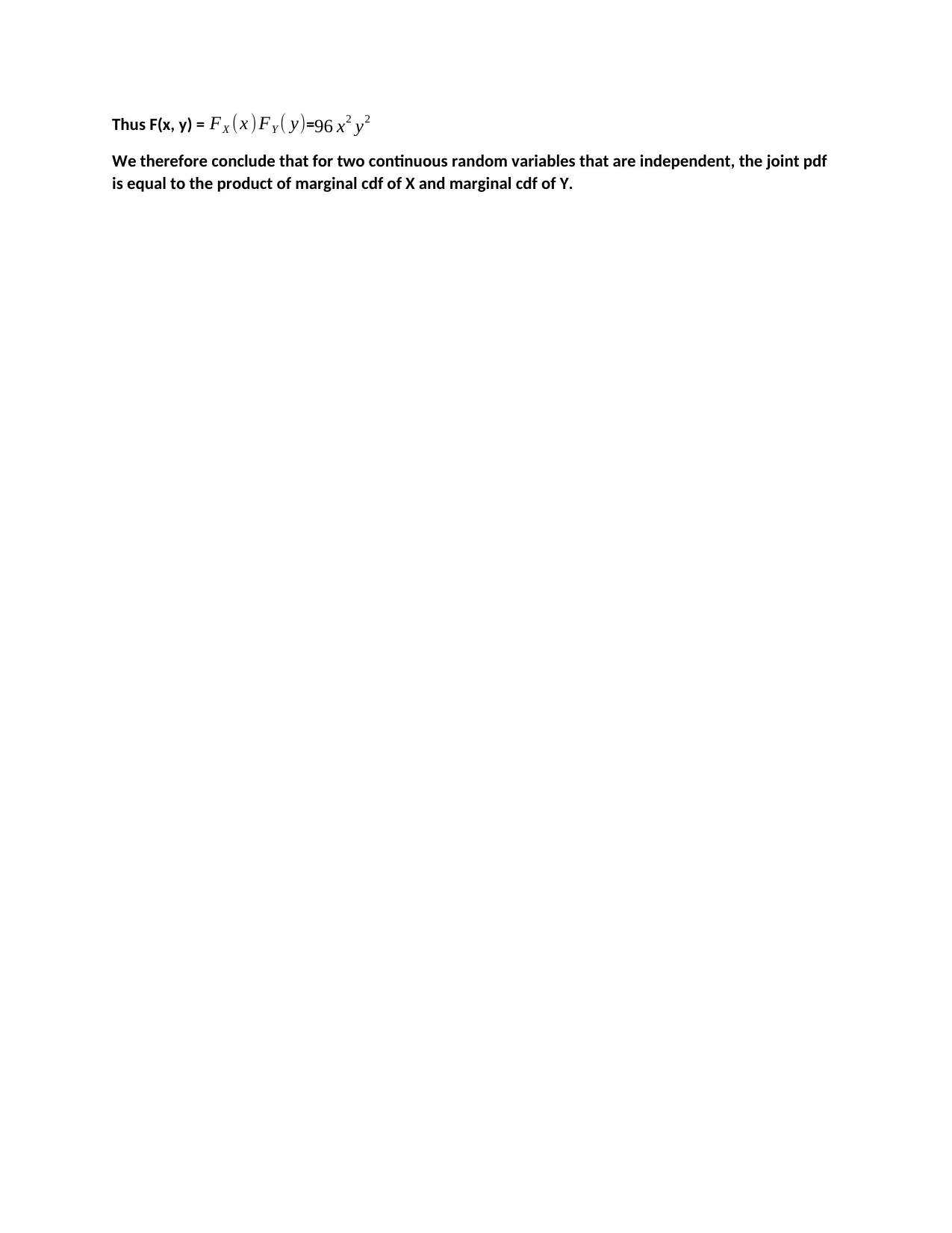
Thus F(x, y) = FX (x ) FY ( y)=96 x2 y2
We therefore conclude that for two continuous random variables that are independent, the joint pdf
is equal to the product of marginal cdf of X and marginal cdf of Y.
We therefore conclude that for two continuous random variables that are independent, the joint pdf
is equal to the product of marginal cdf of X and marginal cdf of Y.
⊘ This is a preview!⊘
Do you want full access?
Subscribe today to unlock all pages.

Trusted by 1+ million students worldwide
1 out of 12
Related Documents
Your All-in-One AI-Powered Toolkit for Academic Success.
+13062052269
info@desklib.com
Available 24*7 on WhatsApp / Email
![[object Object]](/_next/static/media/star-bottom.7253800d.svg)
Unlock your academic potential
Copyright © 2020–2025 A2Z Services. All Rights Reserved. Developed and managed by ZUCOL.





